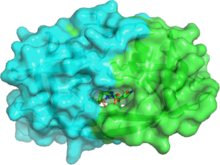Fosamprenavir
- EU EMA: by INN
category
- AU: B3
administration
- J05AE07 (WHO)
- {[(2R,3S)-1-[N-(2-methylpropyl)(4-aminobenzene)sulfonamido]-3-({[(3S)-oxolan-3-yloxy]carbonyl}amino)-4-phenylbutan-2-yl]oxy}phosphonic acid
- 226700-79-4
 Y
Y - as salt: 226700-81-8
 Y
Y
- 131536
- as salt: 131535
- DB01319
 Y
Y - as salt: DBSALT001228
- 116245
 Y
Y - as salt: 116244
- WOU1621EEG
- as salt: ID1GU2627N
 Y
Y
- D02497
 N
N - as salt: D03835
- CHEBI:82941
- ChEMBL1664
 Y
Y - as salt: ChEMBL1200734
- 082186
- DTXSID2048296

- Interactive image
- O=C(O[C@H]1CCOC1)N[C@@H](Cc2ccccc2)[C@H](OP(=O)(O)O)CN(CC(C)C)S(=O)(=O)c3ccc(N)cc3
- InChI=1S/C25H36N3O9PS/c1-18(2)15-28(39(33,34)22-10-8-20(26)9-11-22)16-24(37-38(30,31)32)23(14-19-6-4-3-5-7-19)27-25(29)36-21-12-13-35-17-21/h3-11,18,21,23-24H,12-17,26H2,1-2H3,(H,27,29)(H2,30,31,32)/t21-,23-,24+/m0/s1
 Y
Y - Key:MLBVMOWEQCZNCC-OEMFJLHTSA-N
 Y
Y - as salt: InChI=1S/C25H36N3O9PS.Ca/c1-18(2)15-28(39(33,34)22-10-8-20(26)9-11-22)16-24(37-38(30,31)32)23(14-19-6-4-3-5-7-19)27-25(29)36-21-12-13-35-17-21;/h3-11,18,21,23-24H,12-17,26H2,1-2H3,(H,27,29)(H2,30,31,32);/q;+2/p-2/t21-,23-,24+;/m0./s1
- Key:PMDQGYMGQKTCSX-HQROKSDRSA-L
 N
N Y (what is this?) (verify)
Y (what is this?) (verify)Fosamprenavir (FPV), sold under the brand names Lexiva and Telzir, is a medication used to treat HIV/AIDS.[3][4] It is a prodrug of the protease inhibitor and antiretroviral drug amprenavir.[5] It is marketed by ViiV Healthcare as the calcium salt.[3][4]
Fosamprenavir was approved for medical use in the United States in October 2003,[6] and in the European Union in July 2004.[4] The human body metabolizes fosamprenavir in order to form amprenavir, which is the active ingredient.[3]
A head-to-head study with lopinavir showed the two drugs to have comparable potency, but patients on fosamprenavir tended to have a higher serum cholesterol.[7]
Medical uses
Fosamprenavir is used for the treatment of HIV-1 infections, typically but not necessarily in combination with low-dose ritonavir or other antiviral drugs.[8][9]
Adverse effects
The most common adverse effect is diarrhea. Other common side effects include headache, dizziness and exanthema, which is usually transient. Severe allergic reactions (Stevens–Johnson syndrome) are rare.[8]
Interactions
Amprenavir (the active metabolite of fosamrenavir, which is found in blood plasma, liver and other organs) is metabolized via the liver enzyme CYP3A4 and also weakly inhibits this enzyme. This means that combination with drugs that are also metabolized by CYP3A4 can increase their plasma concentrations and thus side effects; and combination with drugs that inhibit CYP3A4 can increase amprenavir concentrations.[8]
When combining fosamprenavir with low doses of the CYP3A4 inhibitor ritonavir, this interaction is intended as it allows for application of lower fosamprenavir doses.[8]
Pharmacology
Fosamprenavir is quickly activated to amprenavir, even before it reaches the circulation. Amprenavir is a HIV protease inhibitor.[8]

References
- ^ "Telzir Product information". Health Canada. 25 April 2012. Archived from the original on 14 June 2021. Retrieved 2 October 2022.
- ^ "Telzir 700 mg film-coated tablets - Summary of Product Characteristics (SmPC)". (emc). 22 June 2021. Archived from the original on 6 December 2021. Retrieved 2 October 2022.
- ^ a b c d "Lexiva- fosamprenavir calcium tablet, film coated Lexiva- fosamprenavir calcium suspension". DailyMed. 1 October 2020. Archived from the original on 29 January 2022. Retrieved 2 October 2022.
- ^ a b c d "Telzir EPAR". European Medicines Agency. 17 September 2018. Archived from the original on 15 May 2021. Retrieved 2 October 2022.
- ^ "Fosamprenavir Monograph for Professionals". Archived from the original on 2021-06-28. Retrieved 2022-10-03.
- ^ "Drug Approval Package: Lexiva (Fosamprenavir Calcium) NDA #021548". U.S. Food and Drug Administration (FDA). Archived from the original on 15 April 2021. Retrieved 2 October 2022.
- ^ Eron J, Yeni P, Gathe J, Estrada V, DeJesus E, Staszewski S, et al. (August 2006). "The KLEAN study of fosamprenavir-ritonavir versus lopinavir-ritonavir, each in combination with abacavir-lamivudine, for initial treatment of HIV infection over 48 weeks: a randomised non-inferiority trial". Lancet. 368 (9534): 476–82. doi:10.1016/S0140-6736(06)69155-1. PMID 16890834. S2CID 33612672.
- ^ a b c d e Jasek W, ed. (2007). Austria-Codex (in German) (62nd ed.). Vienna: Österreichischer Apothekerverlag. pp. 8009–17. ISBN 978-3-85200-181-4.
- ^ Lexiva. Drugs.com (Report). Monograph.
- ^ Shen CH, Wang YF, Kovalevsky AY, Harrison RW, Weber IT (September 2010). "Amprenavir complexes with HIV-1 protease and its drug-resistant mutants altering hydrophobic clusters". The FEBS Journal. 277 (18): 3699–714. doi:10.1111/j.1742-4658.2010.07771.x. PMC 2975871. PMID 20695887.
External links
- "Fosamprenavir". Drug Information Portal. U.S. National Library of Medicine.
- "Fosamprenavir calcium". Drug Information Portal. U.S. National Library of Medicine.
- v
- t
- e
(Discovery and development)
(Integrase strand transfer inhibitors (INSTI))
(Discovery and development)
| 1st generation |
|
|---|---|
| 2nd generation |
inhibitors (RTIs)
| Nucleoside and nucleotide (NRTI) | |||||
|---|---|---|---|---|---|
| Non-nucleoside (NNRTI) (Discovery and development) |
|
- Abacavir/lamivudine#
- Abacavir/dolutegravir/lamivudine°
- Abacavir/lamivudine/zidovudine
- Atazanavir/cobicistat
- Bictegravir/emtricitabine/tenofovir alafenamide°
- Cabotegravir/rilpivirine
- Darunavir/cobicistat
- Darunavir/cobicistat/emtricitabine/tenofovir alafenamide°
- Dolutegravir/emtricitabine/tenofovir alafenamide
- Dolutegravir/lamivudine°
- Dolutegravir/lamivudine/tenofovir alafenamide°
- Dolutegravir/lamivudine/tenofovir disoproxil°#
- Dolutegravir/rilpivirine
- Doravirine/lamivudine/tenofovir disoproxil
- Efavirenz/emtricitabine/tenofovir disoproxil#
- Efavirenz/lamivudine/tenofovir disoproxil#
- Elvitegravir/cobicistat/emtricitabine/tenofovir alafenamide
- Elvitegravir/cobicistat/emtricitabine/tenofovir disoproxil
- Emtricitabine/tenofovir alafenamide
- Emtricitabine/rilpivirine/tenofovir alafenamide
- Emtricitabine/rilpivirine/tenofovir disoproxil
- Emtricitabine/tenofovir disoproxil#
- Lamivudine/nevirapine/stavudine
- Lamivudine/nevirapine/zidovudine
- Lamivudine/raltegravir
- Lamivudine/tenofovir disoproxil#
- Lamivudine/zidovudine#
- Lopinavir/ritonavir#
| Uncoating inhibitors |
|
|---|---|
| Transcription inhibitors |
|
| Translation inhibitors | |
| BNAbs | |
| Other | |
| Failed agents |
|
- #WHO-EM
- ‡Withdrawn from market
- Clinical trials:
- †Phase III
- §Never to phase III













